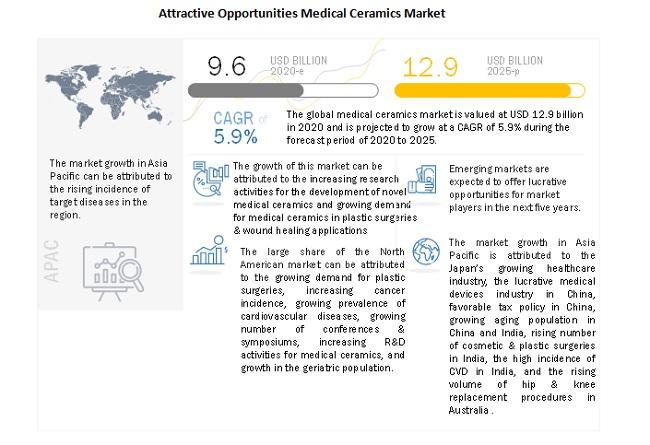The significant growth in the geriatric population is expected to result in an increased demand for joint reconstruction, cardiovascular surgeries, and dental replacement procedures and an increase in the prevalence of hearing loss. These factors are, in turn, expected to support the growth of the hearing, orthopedic, and dental implants market.
Medical ceramics are key components in the manufacturing of various implantable devices, such as orthopedic implants (artificial hips, knee, shoulder, wrists, fracture fixation, and bone grafts), cardiovascular implants (heart valves, pacemakers, catheters, grafts, and stents), dental implants (enamels, fillings, prosthetics, and orthodontics), and hearing implants (cochlear implants).
The development of medical ceramic products involves time-consuming processes and expensive clinical trials. These products have to be implanted inside the human body; they need to be biocompatible and comply with the ISO biocompatibility testing standards. However, it is difficult to anticipate the biocompatibility till the later stages of clinical trials, making companies and investors apprehensive of investing in this market.

Download PDF Brochure @ https://www.marketsandmarkets.com/pdfdownloadNew.asp?id=237425129
[ 187 Pages Report] The global medical ceramics market is projected to reach USD 12.9 billion by 2025 from USD 9.6 billion in 2020, growing at a CAGR of 5.9% from 2020 to 2025. Increasing research activities for the development of novel medical ceramics, growing demand for medical ceramics in plastic surgeries & wound healing applications; the rising number of hip & knee replacement procedures; and the increasing demand for implantable devices are responsible for the significant growth of the market during the review period.
Defects in medical ceramic structures are difficult to find. It is also very difficult to find internal cracks or wear and tear in the ceramic matrix components. The lack of a skilled workforce and proper techniques to repair further highlight the issue of reparability. Medical ceramics have a long lifespan but are not recyclable.
Hydroxyapatite has high biocompatibility, bioactivity, and osteoconductivity; making it suitable for a wide range of applications, such as a bone void filler for the orthopedic, spine, maxillofacial, and dental surgery; restoration of periodontal defects; orthopedic and dental implant coating; bone-tissue engineering; and gene delivery.
Due to its bioactivity, hydroxyapatite is an alternative to allogenic & xenogeneic bone grafts, resulting in shorter healing times. Additionally, it is used as an injectable cement or coating on titanium & titanium alloy implants to reduce the implant rejection rate.
In 2019, 3M dominated the medical ceramics market. 3M has been operating in the market for about 100 years and is engaged in developing and manufacturing a wide range of products in infection prevention, critical & chronic care, healthcare information systems, dental, orthodontic (oral care), drug delivery systems, food safety, and medical device components categories.

